In this post I’m going to show you how to run a successful webinar campaign even if you’ve never run one before. (And if you have used webinars before, you’ll be able to take this strategy and hit the ground running.)
In fact, you’ll see how we generated $149.55 for every person who registered for the webinar AND how we tweaked the funnel to generate even more revenue going forward.
How do I run webinars that get more per registration than a lot of people are making per attendee?
I focus on making sure I optimize every single part of the webinar experience. The truth is there’s more than just the presentation to consider.
Why Webinars?
If you’re selling any kind of digital product or service online with a price point of $500+ you should definitely be using webinars.
Products priced $10 – $100 can be considered impulse purchases that can be sold easily with a traditional long form sales letter or video sales letter.
It’s possible to sell higher priced products using those formats too, but once you start getting into price points in the hundreds, or thousands, of dollars it makes more sense to use a webinar.
Webinars offer you the ability to connect face to virtual face with your future customers and present to them in a more intimate setting.
You get to capture their attention in a way that a sales letter or pause-able video never could.
You get to hear their objections and answer their questions in real time.
When it comes to selling higher priced offers…
Webinars. Are. Awesome.
If you’ve never run a webinar campaign before you can take the framework below as a guideline to create your first presentation.
If you’ve already been using them, you can follow the specific strategies I use to increase your profitability both on the webinar and afterwards, including the replay sequence and beyond.
But before we start, let me tell you a little about this particular webinar, the offer and the results.
Webinar Overview
This webinar was run in conjunction with an affiliate partner. My partner was in charge of sending the visitors (traffic) and I presented the webinar to his audience. In return he received a commission on every sale made.
Running webinars in this way as a product owner is a low-risk approach as you only have to pay out for any sales generated, and then it’s just a share of the sale.
Compare this to something like running paid advertising where there are no guarantees of any results.
The campaign lasted a week – starting on the Monday and ending at 11:59pm on the Sunday.
The Offer
On the webinar the audience were presented with an offer costing $1,997 (or split over 2 payments of $1,099).
It’s a ‘done for you’ type offer where customers get something that is built for them by our team.
Typically ‘done for you’ offers can command a higher price point over just an info product that tells them how to do something. However, I’ve still seen lots of successful webinars where product owners sell a ‘how to’ type info product at the $997-$1997 price point.
Results
Over the course of the week the campaign generated a total of $123,535.00 from 826 registrations.

Of that amount, just under half – $54,428.00 – was collected on the live call, with the remaining amount collected after the encore webinar and follow up sequence.
While a lot of people are happy with 25-30% attendance rates, we managed 51% on our live webinar.

The Webinar Sequence
I’m going to break down the process into several specific parts. Each one is just as important as the next, and by optimizing each step, the gains you make will compound as leads go through the whole sequence.
Phase #1 – Research phase
This phase is important. Not everyone does it and results will often reflect it.
Before even running the webinar you want to make sure that the offer you’re going to present is something that your audience wants.
If you don’t know what your audience wants, here’s what you need to do:
ASK them.
Find out what their biggest problems are. Find out what’s holding them back and what keeps them up at night.
Your offer should solve these problems for your audience in some way.
Not only that, but your presentation and promotional materials for the webinar should agitate these problems and tell them how it’s possible to solve them.
Phase #2 – Pre-webinar
Our webinar was scheduled for Wednesday at 7pm EST, but the promotional campaign started on Monday.
For this, the affiliate created a video that talked about the problems and pain points that the audience were experiencing and then invited them to the upcoming free webinar that would help them overcome those problems.
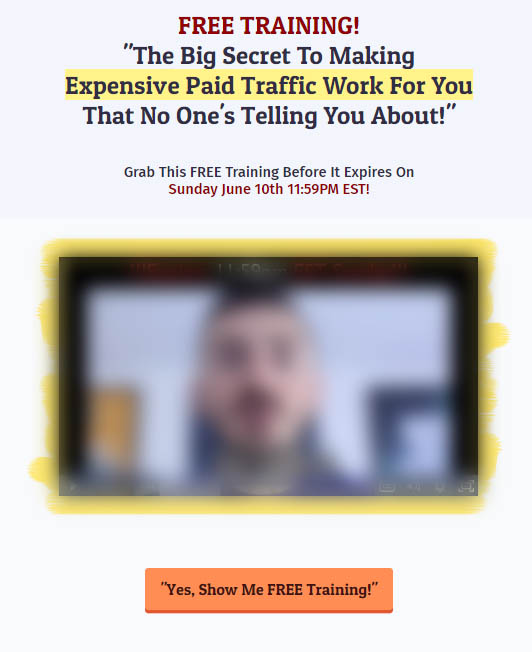
As well as this we also promised to give attendees a special bonus which was a ready-made campaign that they could use immediately after the call to get results.
We also referenced the fact that there were limited places on the live call. This scarcity encouraged people to make sure and register right then to avoid someone else taking their place.
It’s important that this scarcity is real – our webinar software would only allow 500 attendees at one time – as while scarcity is a powerful ally when it comes to influencing people, if it’s not authentic you lose all credibility and trust.
This pre-sell video was hosted on a simple page that had a link to the webinar registration page. At the end of the video, the viewer was encouraged to click through to that page and signup.
Registration Page – The video above went a long way to getting people interested in signing up. On the registration page there are several steps we used to ensure that we got the highest possible optin rates.
- The registration page has a pre-headline that tells people the webinar is for subscribers of the affiliate. This lets people know they’re in the right place.
- The name/picture of the affiliate is shown beside my own name/picture. This is important because people will be getting notifications from me regarding the webinar so it’s essential they know who I am.
- There’s a countdown timer that counts down to the webinar start time. This instills a sense of urgency.
- We again reference the free campaign people get for attending as well as the limited spaces.
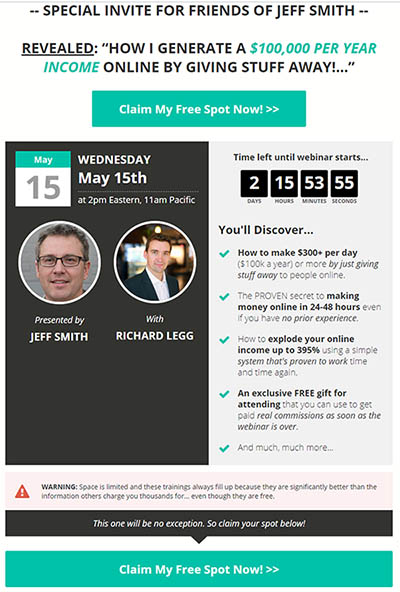
Thanks to the strong pre-selling video we were able to get 85% of people who landed on the optin page to register.
Post Registration – Once someone registers they get an automated email with their login link to the webinar. They’re also taken to a static ‘thank you’ page.
On this page the first thing they see is a video welcoming them and also re-selling them on the benefits of attending e.g. the three secrets they’ll learn to do _______, the free campaign they can use to get results as soon as the call is over and also re-stating the fact that there are limited places.
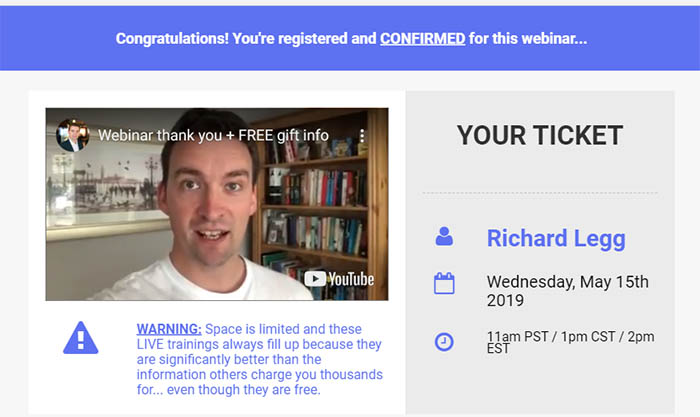
We then have a series of numbered steps for them to complete.
Step #1 – There is a button to get a reminder sent via Facebook Messenger 15 minutes before the webinar goes live. For this we use ManyChat and it gives us another method of contacting the lead during the campaign. As an incentive to get them to sign up we also offer to send them the transcript of the call afterwards along with the ready made campaign. So even if they’re not worried about getting the reminder, this is often enough to encourage them to signup.
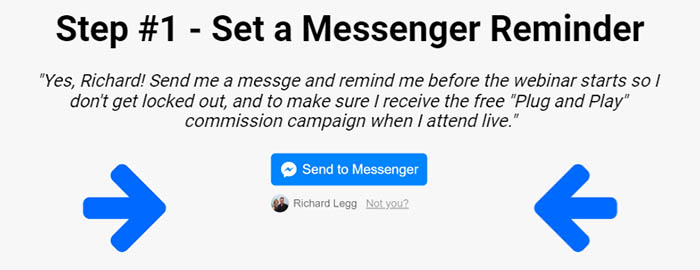
Step #2 – Make sure to look for their unique webinar link in their email inbox and if they haven’t received it, give them a link to sign up again. Some people will mis-type their email, or just deliberately provide a false email, so this is a way to capture some of those people.

Step #3 – Remember to attend. This is just a simple step but again allows us to reinforce the fact that they should attend because (a) there are limited spaces on the call and (b) they’ll get the free campaign when they do.
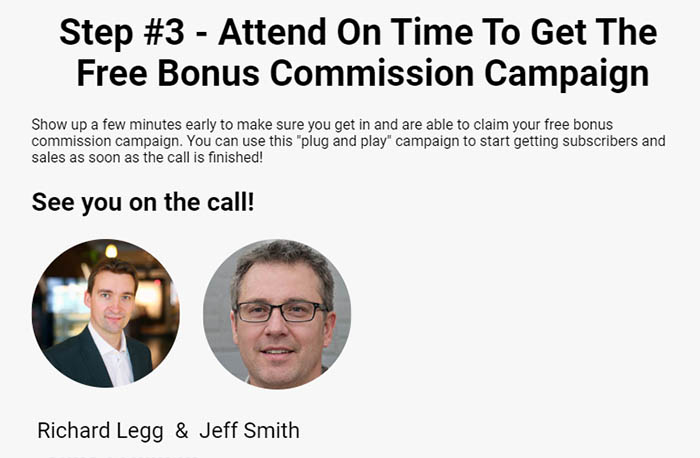
Follow Up – The affiliate continued promoting the webinar up through Wednesday evening when the webinar went live.
In addition, all registrations got reminders from the webinar software provider – in this case GoToWebinar – at 6 hours, 2 hours and 1 hour before.

We also sent an email and Facebook message to registrations 15 minutes before the webinar went live.
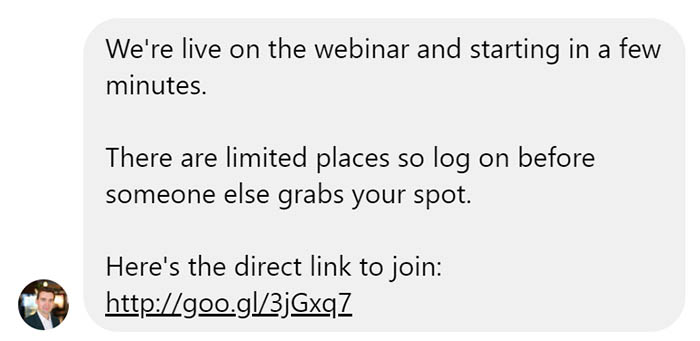
Finally we also sent an email reminder 15 minutes *into* the webinar.
![]()
After 7pm the main registration page was changed so that any visitors would be immediately redirected to the webinar software login/registration page so that they could get into the live room without being redirected to the previous thank you page etc.
All of these steps enabled us to get a 51% attendance rate on the live webinar.
Phase #3- Live webinar
On the live webinar we followed a pretty typical presentation format as below:
- Welcome to the webinar
- Introduction. Tell them what they’ll learn and give them the big promise.
- Who you are. Show them why you’re qualified.
- Explain problems in reaching goal with current methods.
- Explain that there’s a new method that works better/faster/easier.
- Content section – cover 3 actionable steps they can take.
- Transition. Explain how these 3 steps only go some of the way.
- Introduce offer. How your product/service helps them complete their goal.
- Detail the offer. List all the elements included.
- Stack value. Add bonuses to cover objections and anchor pricing.
- Reveal price. Price should be significantly lower than total value.
- Risk reversal. Offer some kind of guarantee to remove risk.
- Limit the offer. Make it time or quantity limited to encourage purchase.
- Q&A. Handle objections and questions for as long as needed.
- End webinar and close offer.
When it came time for the pitch we had 295 people on the call.
We gave people the link to the offer checkout page and continued with the Q&A session to answer any outstanding questions or objections.
The checkout page was a summary of what they were getting – essentially the same as the last ‘stack’ screen in the presentation. It also had the guarantee, a series of testimonials and then the buy buttons.
At the top of the page was a countdown timer set for 30 minutes.
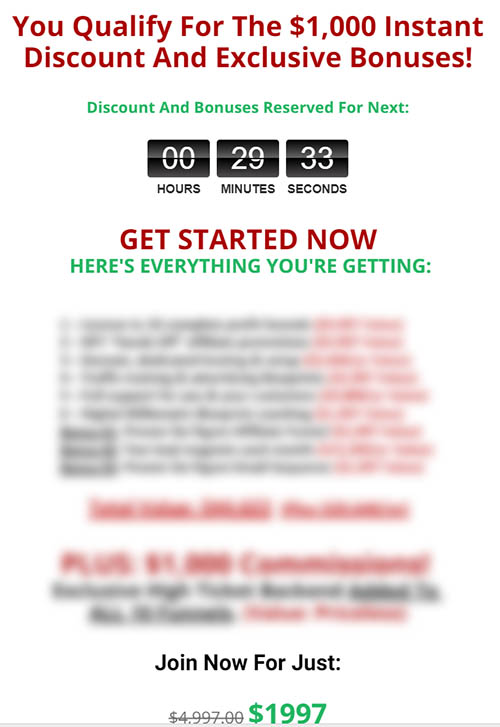
After this timer expires the page will automatically redirect to a checkout page at a higher price point and if they want to access it again they have to start the checkout process from the beginning.
This works in much the same way as something you might find on a site selling concert tickets where your spot is reserved for a certain time and if you don’t complete checkout you’re bumped out and have to start over.
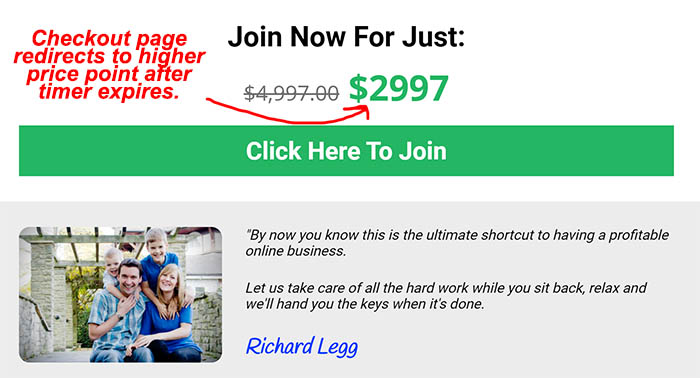
For this webinar the affiliate also offered his own unadvertised bonuses which increased the overall value of the package that people were getting.
Of the 295 attendees at the pitch 34 people purchased at either a $1997 price point or 2x$1099 (11.5% conversion rate)
In total we collected $54,428 on the live call ($70,193 total when accounting for the remainder of funds from people who took the 2-pay option)
At this point we’d generated $65 per registration – not per attendee, but per registration – in *collected* funds.
Phase #4 – Encore webinar
The following day we ran an encore webinar. Some people like to run these as live webinars again but we just ran the recording of the previous nights webinar.
The main reason for this was that being in the UK meant I was online until 4am after the previous webinar and didn’t want to do that again. (My kids still wake me up at 7am regardless)
Still, just by running the recorded encore we added an additional $12,585 in revenue. Not bad for the extra 15 minutes work it set to configure in GoToWebinar.
However, if we did run another live webinar my guess is we would have made even more just because of the fact you can personally answer people’s questions live on the call..
Phase #5 – Replay sequence
With attention spans decreasing and attendance rates dropping, the replay sequence is often where most of the revenue comes in.
This time was no different.
The replay sequence ran from Friday until 11:59pm on Sunday.
During this time both the affiliate and myself followed up with the leads via email. This is essential – often I see webinars where the affiliate is mailing their list, but the webinar owner doesn’t mail the registrations themselves.
As the campaign got closer to the end, the email frequency also increased.
For example 2 emails on Friday, 3 on Saturday and 4 on Sunday.
Is that a lot?
Yes.
But, at this point we want people to make a decision.
They don’t necessarily have to decide to join, but they should be making a choice one way or the other. If you don’t email them, they’ll just forget about the offer with the 100+ other emails they’ll get that day.
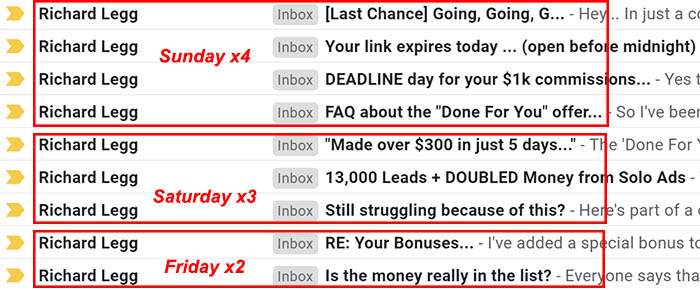
How to structure your replay sequence
When it comes to the type of emails you’re sending during the replay, you don’t want to just send a link to the replay video.
In fact, for this campaign we used a two-phase approach.
The first phase sent people the whole webinar replay video. This is for people who missed the live event for whatever reason, but still wanted to get the content and learn the strategies we revealed on the call. This replay was sent out just for 24 hours on Friday.
The second phase directed people to a shorter recap video. While the full replay was close to two hours long, the recap was closer to 30 minutes. In this video we spent roughly 5 minutes summarizing the different strategies taught on the webinar and then went into the pitch for the offer.
The idea behind this shorter recap is that by now most people will have seen the content part – either through the live webinar, encore webinar, or full replay video. Now we just want them to join if they’re ready.
If someone is excited about this, the last thing we want for them is to have to sit through 60 minutes or more of content before they see the pitch again. So for the last 24-48 hours of a campaign, a shorter recap video is a great way to keep people engaged.
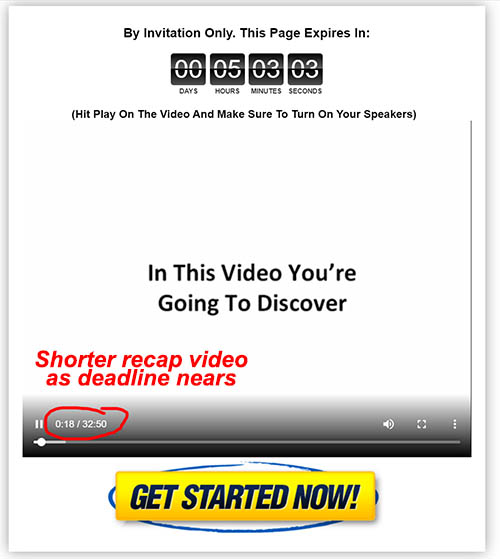
Beyond the ‘replay then recap’ structure, it’s important that your emails also have a strong ‘reason why’ for being sent. People are going to get bored and annoyed if you’re mailing them 2-4 times a day just with ‘go watch this video and signup’ messaging.
When it comes to our campaign we focus on a few key elements that we want to convey:
Proof – We’ll send out different emails that recap different proof elements. It’s a good idea to use both elements from the presentation, but also new proof that you haven’t shown.
Testimonials – People are going to assume that you’ve had results with the product/service you’re offering so it’s important to get 3rd party testimonials to show that it works for other people too. If you know your target market well you should have a clear idea of the type of person you’re targeting.
It’s essential that you have testimonials from people that represent your target market so viewers can see other people just like them getting results. You don’t have to be restricted to just these types of testimonials, and in fact having proof from a wide variety of people is very powerful, but just make sure your target market is represented.
Fast Action Feedback – If you’ve had people go purchase your offer and they’ve achieved results quickly, make sure to include this in your emails. This is an extension of the testimonial section above, but people not only want to know it’s going to work for them, they also want to know that it’s not going to take a long time.
Bonuses – As the deadline gets nearer it’s always worthwhile adding more value to the package in the form of additional bonuses. Increasing the value will increase the fear of loss. Combine that with the increasing urgency from the deadline and it can be a very effective motivator.
When it comes to bonus ideas, think about the main objections that you’ve experienced from people who are interested in purchasing but just have one or two small doubts. By including bonuses that deal with these objections you’re not only increasing the value but also taking away reasons for people to not buy.
Scarcity – You should never underestimate how powerful scarcity in the replay sequence is. People are motivated by a fear of loss and having a hard deadline will help get people to make that decision. In some campaigns we’ve seen as much as 50% of the total revenue come in during the last 24 hours alone.
Think about that…
If a campaign did $100,000 total, with $50,000 coming in the last 24 hours, you’ve effectively doubled your total revenue just by mailing hard in that last 24 hours.
Your replay/recap pages should have a countdown timer at the top of all pages during this replay sequence, but you should also include them in the emails themselves.
A big, bold red timer counting down in an email really grabs attention and reinforces the need for them to take action and at least watch the video before it comes down.
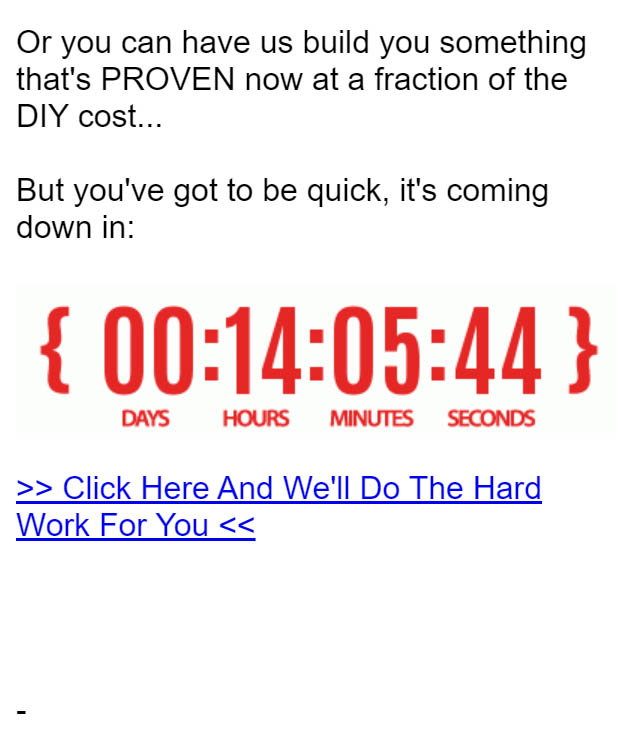
Psychic buy buttons – This is an extension of the ‘replay then recap’ strategy. Remember we use a shorter recap so people don’t have to watch a longer replay. Psychic buy buttons use a similar idea.
Often when sending people to a video sales letter you don’t want the buy button to be immediately visible. You want the video to build the value and sell the offer before you ask for the sale.
If the buy button is always visible on the page, the viewer knows they’re being sold to before that value has been built. They can click through, check out the price, and then just decide to leave. This isn’t so much an issue with a $10-$100 price point, but when you’re selling ~$2000 offers you need to build the value before they get to the price.
Typically the way to deal with this is to delay the buy button with some code so that it only appears after a set period of time once the offer is made
Since we’re using a more aggressive email sequence, it’s possible that people may have seen the offer one or more times before they decide to invest. If they get an email on the last day and are ready to invest, you don’t want them to have to wait another 20-30 minutes for the buy button.
With the psychic buy button you can track who has seen the offer and who has not. For those people who have seen the offer and are returning to the page, you can have the button show immediately (or with less of a delay). For new visitors who have not yet seen the offer, the button is delayed for the whole time.
Finally when it gets to the last ~6 hours of the campaign we just set the button to show instantly. At this point almost everyone will have been exposed to the offer via the webinar, encore, replay or recap so we want people to be able to purchase as soon as they decide they’re ready.
Webinar Totals
At the end of the campaign we’d generated $123,535.00 in revenue which worked out to almost $149.55 per registration.
Not bad, right?
There was just one problem with this.
We could have made more. This is how…
Webinar Upgrades
With a successful webinar in the books, these are some of the things we did to increase revenue and turn the webinar into a long term asset.
Upsell
After running that initial webinar successfully, I added a $5,000 optional upsell. This was something that I had to think carefully about as not everyone is a fan of being presented with another offer right after they purchase something, particularly at a ~$2000 price point.
It’s made clear to buyers that this is a completely optional upgrade as the last thing I want is for them to feel like the main product won’t work without this upgrade.
The truth is most people don’t need this upsell and I tell them that. But for those that are a fit and can invest in it, there is a lot of value in it for them.
To sell this offer I setup an ugly little sales page that was tied to my evergreen scarcity system.
The reason I used a plain/ugly page is that I wanted to discourage people who were not a fit, so that those who did purchase were doing so because they saw the value in the offer, not in the pretty design of the page or anything like that.
The evergreen scarcity system with this gives every lead their own unique deadline for the offer which is set to be midnight the day after they join. I don’t need to remind you how strongly a hard deadline can motivate people so it would be foolish not to include some kind of scarcity here.
However, it’s difficult in most cases to create a real deadline on such a short timescale considering people can be joining at any time. If it’s an offer that everyone is seeing at one time – like the live webinar sequence – then everyone can have the same deadline which is easy to implement.
The difficulty comes when Bob joins on Monday, Tim joins on Wednesday and Mary joins on Saturday. Each of those people would need a different deadline and that’s where the evergreen scarcity system I developed works. It makes sure each lead has a deadline that is tied to when they joined the main offer.
It also works across all emails and pages, and even more importantly will always display the correct deadline no matter what device they use, what IP address they use, or whether they have cookies enabled/disabled or deleted.
So far this upgrade is adding ~$400 in revenue per buyer.
Payment Plan Re-Opening
On the live webinar we offered two price points – a full pay at $1997 or a split pay of 2x$1099 that are 30 days apart.
I’ve seen other people offer even longer payment plans, and while they can be useful, I think it’s often a mistake to provide those upfront.
In my experience there is always going to be a drop-off in payment plans. Not everyone is going to complete all of the payments.
It’s also true that if you offer a payment plan upfront, you’ll have people who would have taken the full price option if that were the only one available. But by giving them the payment plan option they will take that, and a percentage of those will not complete the term. In effect, you’re cutting down on the total revenue.
Instead for this campaign, a payment plan is only offered AFTER the main sequence has finished. To do this I send out an email a few days later asking what was the main reason that people didn’t invest.
The vast majority of people will tell me it’s that they couldn’t afford the full amount at that time.
This gives me a very strong ‘reason why’ to open up the offer again for a limited time. To do this I’ll email all the webinar registrations and let them know that for 48 hours they can get instant access to everything but pay it off over 12 months e.g. 12 payments of $197. I’ll also tell them in the email that I’m doing this precisely because they told me that the price point was an issue.
By doing this we get a large number of those non-buyers to invest. In some cases we get more front end sales of this than we do from the main webinar sequence.
As expected not every customer will complete the full payment term, and on average we collect just under half of all expected payments, but this is all essentially found money. By only making this available after the main webinar sequence is over it also ensures we don’t sacrifice any revenue during that first sequence.
These buyer are also shown the $5,000 upgrade mentioned above and while they convert less than people who pay in full, we do still get people upgrading from the $197 purchases.
More Offers
Just because someone hasn’t purchased at this point, it doesn’t mean they won’t purchase something else.
For this next sequence I have a product that sells for ~$500 that’s almost like a ‘lite’ version of the main offer. Instead of doing everything for them, the smaller product is a more ‘do-it-yourself’ option with templates etc to help them.
The way I sell this is I first ask people what they want e.g. would they want training on how to do everything themselves, or would they prefer that I give them the templates they can just ‘plug in’. I ask them to just click a link to a one-question survey to give me their answer.
(You can also ask people to just reply with the answer, but I like to use the survey because I can take the results and show a screenshot as proof in the next email)
Given human nature I already know what the answer for the majority of people is going to be – they’ll want to do as little as possible.
This helps me frame the rest of the emails though where I share the results of that mini survey with them and then explain that I’m going to put together an offer that gives them what they ask for.
Again, it’s important here that I’m not just pitching them something for the fun of it. It’s framed as them asking me for something and then me providing them what they specifically asked for.
The email sequence for this has a couple of days explaining what’s going into the package, along with a lot of proof elements of how well it’s worked. I want to build up the anticipation here as much as I can.
Finally I’ll open the cart and the offer will be available for three days.
During those three days I’ll use the same style of campaign as for the webinar replay sequence e.g. focussing on proof, testimonials, fast action feedback and using the scarcity to motivate people to make a decision.
The first time this campaign ran it generated over $48,000 in the three days it was open. The evergreen scarcity system is also extremely valuable for this offer – it increased total revenue by 170% compared to just using a vague ‘closing soon’ statement with no actual deadline.
For some webinar campaigns this ‘lite’ version sold in the follow up sequence has added 25% to the overall revenue from the main webinar sequence.
The key takeaway is that just because someone doesn’t buy from the webinar/replay, it doesn’t mean they won’t buy at all.
Automate It – Work Once, Get Paid Forever
Since running that first webinar we’ve turned it into an automated webinar – that can run everyday on autopilot, or on a fixed date/time as a ‘like live’ webinar so that I don’t have to be up until 4am here in the UK – and also improved the overall profitability with a few simple additions.
In fact this offer has generated over $2 million in revenue and the only live webinar I’ve ever done was the one used in this case study. All of the other $2M+ revenue came solely from automated webinars.
While automated webinars are not new, a lot of people tend to use them more like a video player. For example they’ll just put a video recording into the software and then call that their automated webinar.
The truth is if you want an automated webinar to work really well then it has to model a live webinar sequence as closely as possible.
That includes the same kind of pre-webinar sequence, a ‘like live’ webinar with urgency in the offer, a full replay/recap sequence with scarcity from a real deadline with each lead.
Once you get this, it’s possible to generate dollar-per-lead values very close to those with a live webinar setup.
This is what I do for clients and have created similar webinar for them that have generated over 7 figures in sales without them ever having to jump on a live call or talk to any customers before they buy.

Leave a Comment